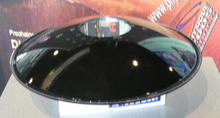| Revision as of 11:58, 20 February 2006 editRnt20 (talk | contribs)Extended confirmed users, Pending changes reviewers6,005 editsm Typo← Previous edit | Revision as of 06:43, 28 February 2006 edit undo125.190.137.42 (talk) →External linksNext edit → | ||
| Line 21: | Line 21: | ||
| * ]: An imperfect reproduction of a parabolic reflector | * ]: An imperfect reproduction of a parabolic reflector | ||
| * | * | ||
| * Free IC DataSheet Search Site : http://www.Datasheet4U.com | |||
| ] | ] | ||
Revision as of 06:43, 28 February 2006
A parabolic reflector (also known as a parabolic dish or a parabolic mirror) is a reflective device formed in the shape of a paraboloid of revolution. Parabolic reflectors can either collect or distribute energy such as light, sound, or radio waves.
The parabolic reflector functions due to the geometric properties of the paraboloid shape: if the angle of incidence to the inner surface of the collector equals the angle of reflection, then any incoming ray that is parallel to the axis of the dish will be reflected to a central point, or "focus". Because many types of energy can be reflected in this way, parabolic reflectors can be used to collect and concentrate energy entering the reflector at a particular angle. Similarly, energy radiating from the "focus" to the dish can be transmitted outward in a beam that is parallel to the axis of the dish.
Isaac Newton introduced parabolic mirrors into practical astronomy when he invented the reflecting telescope. The most common applications of the parabolic reflector are in satellite dishes, telescopes (including radio telescopes), parabolic microphones, and many lighting devices such as spotlights, car headlights, PAR Cans and LED housings.
Parabolic reflectors suffer from an aberration called coma. This is primarily of interest in telescopes because most other applications do not require sharp resolution off the axis of the parabola.
The Olympic Flame is lit using a parabolic reflector concentrating sunlight.

A toy consisting of two parabolic mirrors that are put together like a wok pan and a lid with a hole in it, gives the optical illusion that something is on the lid, but actually it is at the bottom of the pan below.
See also
External links
- Solar Death Ray: An imperfect reproduction of a parabolic reflector
- Java demonstration of a parabolic reflector
- Free IC DataSheet Search Site : http://www.Datasheet4U.com